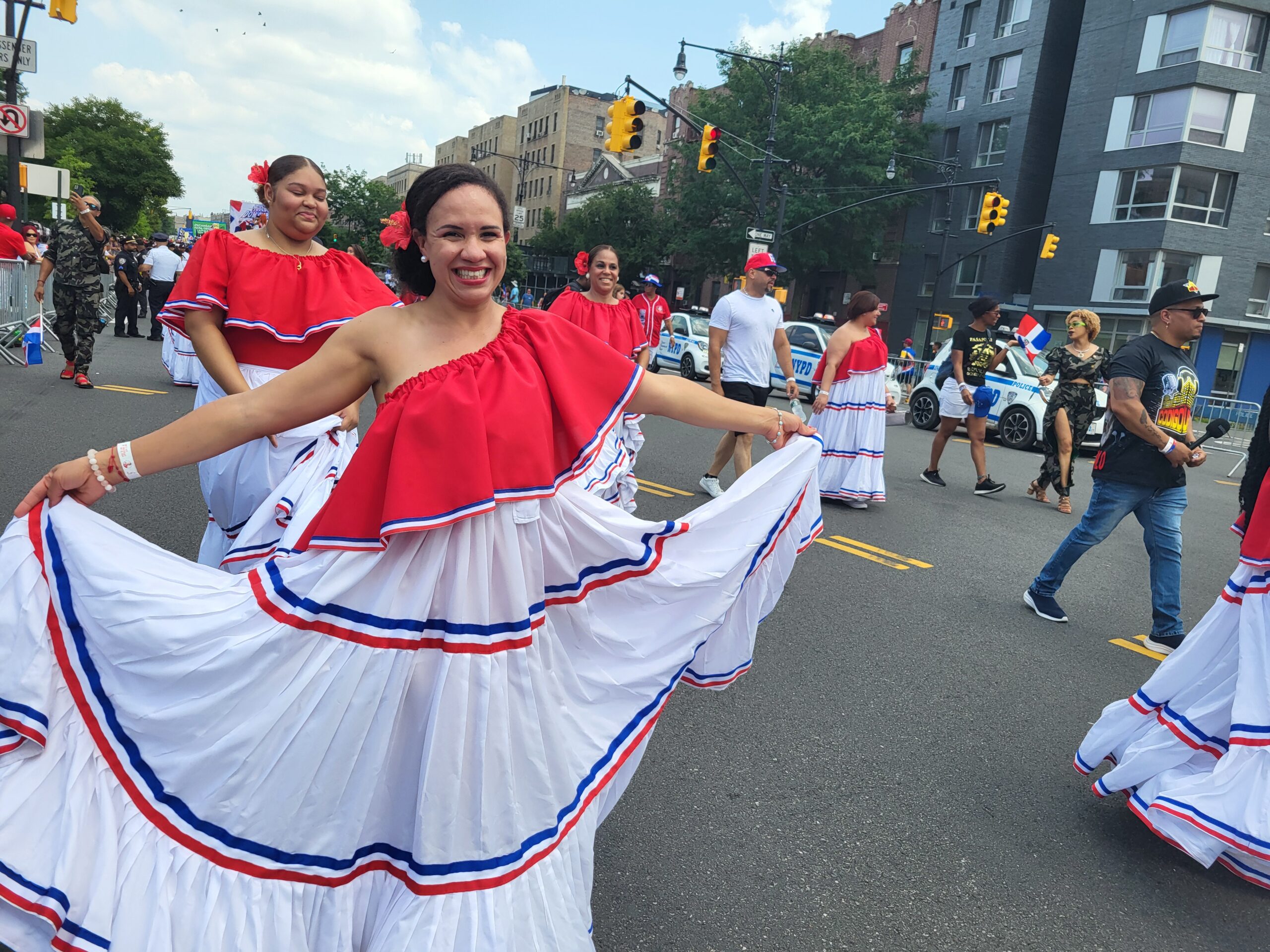As a famous song from the genre says, “if you have fun dancing merengue,” it is clear that you can also have fun marching on the last Sunday in July during the Great Dominican Parade in the Bronx, which this year celebrated 35 years of its establishment.
For this purpose, the Grand Concourse Avenue—the main artery that crosses several neighborhoods in the heart of the largest Dominican community in New York—had already been painted red, blue and white, the colors of the island flag, before noon, to welcome the tens of thousands who took to the streets to celebrate Dominican culture.
On every corner, plates of chicken with spaghetti and rice with beans sweetened the atmosphere and provided enough protein to face the onslaught of the day to come, filled with lots of dancing, shouting and pulling. To help digest the food, there was the option of dancing or piraguas, those ice cubes that are served in as many flavors as there are colors.
“What’s your thing?” a local named Wilbert greets this press correspondent covering one of New York’s most emotionally impactful street parties. He then boasts: “I come from the best country in the world.”
—Explain to me why? — the reporter challenges him.
Then Wilbert stretches out his arm and shows the visitor the street parade where young people of both sexes move their bodies, anxious in the face of the competition of rhythms coming out of the speakers that each contingent installed in their cars or floats.
The host finishes by showing the face of his son, who is barely three years old: “Doesn’t he look Spanish? We are a race where many others come together, we are the best,” he insists.
The loud music moves the insides, but even if it weren’t so loud, a Dominican would give himself away because he couldn’t stop moving to the proposed rhythms that go from romantic bachata to dizzying merengue or erotic reggaeton that, like certain fatties, goes straight to the hips. It’s not strictly a music festival, but it seems like it.
Suddenly, although some clouds offered a respite to the participants, the event took place almost entirely on a sunny day. However, it seems that the weather does not calm down, but rather it raises the spirits of those who thrive on the stimulus of the star.
The New York Journal says present

The Hispanic Champion float was once again part of the historic parade in El Condado de la Salsa that vibrated to the fullest.
Among the participating floats, there is one in particular that draws attention. It bears the initials of El Diario de Nueva York and when you find it in front of you, the first thing you hear are the notes of the duo Liza and Willie who come riding on the float singing live. They met at Newtown High School, Queens, New York in music class. After becoming great friends and writing songs together, they decided to form this duo after belonging to several bachata groups that ended up dissolving.
In this parade, they are celebrating a decade of being “Liza and Willie” and that is why in the Sunday parade they inspire with songs like “Culpables”, “Siempre”, “Vivir Sin Tu Amor” and “Perdón” which is one of their most recognized on Spotify.
Also riding on the float of El Diario de Nueva York were Dean Ana García Reyes and Dr. Wilfredo Burgos Mato, both from Hostos Community College. Friends of this publishing house such as Eusmeiry Bello, Yolanda Soto and Michael Gómez, who, although they came up late to the stage, caught up dancing and celebrating all the tunes.
When Liza and Willie’s music takes a break as the parade suddenly slows down, DJ Don Rafa is ready on the top of the same carriage mixing the best tunes from the Dominican Republic. During this time, dozens of dancers gather around the carriage and respond to the sound provocations offered by the DJ. The party then becomes one on and off the bus.
Batucada in the four corners

The Grand Concourse Avenue in the Bronx was once again filled with the Dominican cultural spirit.
As with every celebration, there were people who were not so cheerful on the sunny Sunday afternoon in the middle of summer. The ladies Rosa Maldonado and Caridad Correa, who had put on their best trousseau for the occasion, regretted the one-hour delay in the start of the event.
“We have come every year and we have never been kept waiting,” they complained under a tree on the Grand Concourse.
Another who took advantage of the stop to demand justice was Martha Núñez of the Civic Union, who clarified to El Diario that there were “more than 2,500 missing people in the Dominican Republic and until now there has been no justice.” She insisted that both the current government, as well as the UN and the OAS “have been indifferent to the human rights of Dominicans.”
However, Mrs. Núñez suddenly forgot about the complaint and accepted that she also came to celebrate belonging to this country. She discreetly sings some of the soft tunes that bid farewell to the Key Food supermarket truck, also sponsors of the event that, as a Community Organization, was founded by Felipe Febles on May 3, 1989, just over 35 years ago.
At some point in the afternoon, the delay that had concentrated the celebration between 190th and 180th Avenues was finally cleared and so all attendees were able to enjoy the dancing, live music and gifts that were distributed from the participating trucks.
In the end, the party slowly moved to the large artistic stage located in the same Concourse at the height of 168th Street, where more than three dozen artists of different genres planned to continue the celebration until the sun disappeared.
Leaving the public with the promise of a new Grand Dominican Parade in the Bronx that will surely return in 2025.
